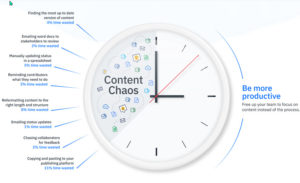The global pandemic was the catalyst for the University of Tennessee‘s need for a centralized location for content and a way to quickly communicate while involving key stakeholders.
The Office of Communication and Marketing team with the university needed a central place for collaboration, a place with visibility, where all the stakeholders could see the work along the way, add feedback and then approve it. Once at the approved stage, they could easily and readily publish to the desired channels or platforms.
The need for a content platform was mission-critical.
We spoke to Christopher Echols, Director of Digital Communications at the University of Tennessee and Craig Cook, Senior Interactive Art Director, to find out more about the impact that using a content operations platform has had on their work.
“Efficiency is critical and the efficiency of our work has increased by using GatherContent”
The old workflow fell apart rather quickly under duress
They were initially using Google/Word docs and email approvals to produce content. This meant that the docs were being passed around, and who knows if the correct version got to the right person at the right time. Christopher Echols shared:
“The spreadsheet model was too rigid; we needed a way to make the information from the key spreadsheet more consumable.”
When the Pandemic pushed them into the world of high-velocity content ops, relying on this way of work quickly proved unstable. Due to extreme time pressure and sensitivity to the need for accuracy, they could no longer stick to this way of working.
They had this very pressing need to collaborate on content creation and no platform in place to handle the demand. This was when GatherContent looked like the answer to their problems. GatherContent would give them confidence that the version being worked on was the most recent and up to date. Everyone who needed to be involved had access to work on that one content item rather than multiple versions of documents being emailed and shared.
Time is a Luxury
“We were able to onboard and begin using the platform effectively without any formal training. Even in a high-pressure situation, we were able to jump in and start collaborating right away. I’ve never seen a piece of software be adopted so quickly.”
Christopher noted this was highly unusual. In the past, the person who sits at the end of their communications line was often not involved in the content creation process. This resulted in issues when the content got to the final person (the publisher) and they sent out the test email. If someone requested changes, it became their responsibility to traffic those changes through the workflow, get it sent back and changed when they were only supposed to be publishing. Further explained by Christopher’s words:
“This was a huge waste of time and not efficient.”
Centralized Collaboration Resulted In Better Buy-In
Content workflows in GatherContent, and having a central place where all stakeholders involved in the project can see the content at every stage solved these efficiency problems.
The primary objective with bringing in GatherContent was to jump in head-first on creating a joint information communication center as a result of the Pandemic. The first area to collaborate on was a website that helped communicate all the decisions and changes that were being made. They had a massive spreadsheet of questions and answers that the team developed during that process. Christopher shared this analogy:
“It was like, literally, in a pandemic, the ‘spreadsheet of doom.’”
Tasked with getting the information that was being added to this very rigid spreadsheet, onto a website, and out into emails so that people could get the information they needed related to ongoing university operations in the Pandemic. They had struggled with the spreadsheet and the process until they finally decided to actually ‘put’ the spreadsheet into GatherContent. There were sections for the questions, answers, and categories in the project, which they were able to do by using the template feature in GatherContent.
They reconfigured over the first month and a half based on their GatherContent model to make it a knowledge base. So it was articles rather than just information. They were able to group the information in a way that was much more useful, searchable and usable for their students in particular. All of this came from the way that they ended up organizing their content in GatherContent.
The answer to more problems than expected
It helped the university’s communications team to think about workflows and processes in general. Before the pandemic, they had talked about how to change their processes and how to document them. Then the pandemic hit, and they never really closed the loop on this idea. Things just had to get done. When they brought GatherContent into their task structure, it gave them a systematic way to document some of these workflows that they didn’t have before.
“We found that GatherContent has enabled us to utilize its strengths to shore up some of our organisational weaknesses”
Christopher highlighted that the tool ended up being valuable far beyond just a nice tool to author content, it helped them to identify where they weren’t collaborating or putting processes into place.
“I think it is an additional value to the platform that is beyond just the features of GatherContent.”

